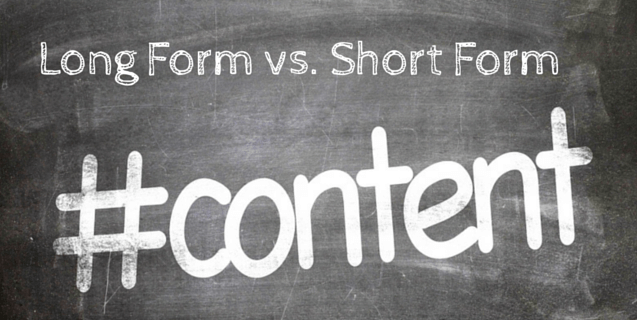People around the world are more connected than ever before, with Pew Research Center reporting earlier this year that 64 percent of American adults use smartphones. Include the number of tablet, laptop, and desktop users, and you end up with a lot of people reading a massive amount of content. For businesses, this offers a variety of opportunities to engage loyal customers and reach new leads.
However, when generating content for your business, is long form content better than short form content— or is it the other way around? The answer is that both long form work and short form work play a crucial role in your company’s marketing mix.
Long Form Content
Definition: “Long-form content is described as content that is typically 2,000 words in length or thereabouts and makes for a compelling, insightful read,” wrote Search Engine Watch contributor Salma Jafri in 2014. “Examples of long-form content include whitepapers, e-books, guides, resources, videos, and webinars.”
There are a number of reasons to use long form content. First and foremost, omnipotent search engine Google will rank a long form piece of content over a short form one. Founder of The Sales Lion, Marcus Sheridan, explained this concept in a blog post, “If Google has a choice to show two articles for the same keyword, which one are they going to choose: The one where readers average 45 seconds on the page or the one where readers average 4.5 minutes on the page?”
Other reasons to incorporate long form pieces into your content marketing strategy? In-depth blog posts, informative white papers, educational webinars, and similar types of content are the perfect platform to demonstrate expertise on a specific topic and/or industry. Additionally, your company’s long-form content provides valuable information to a highly-invested audience that wants to learn more about your area of expertise.
While it may seem hard to believe, long form content is shared more frequently than short-form pieces. In a blog post published on The Huffington Post in June 2014, written by BuzzSumo founder, Noah Kagan, he shared, “The longer the content, the more shares it gets, with 3,000-10,000 word pieces getting the most average shares (8859 total average shares).”
Short-Form Content
Definition: Short form content is typically 400-600 words, can be read in as little as two minutes, and doesn’t require much critical thinking.
“There is a definite trend toward small,” commented author of The Content Code, Mark Schaefer. “If we can’t get big chunks of content through a limited ‘pipeline’ of brain cells, maybe we can get grains of sand through. This would explain ideas like Vine (six-second videos), infographics, and even Pinterest, which is simply easy on the eyes without a lot of processing.”
Blog posts under 1,000 words, social media content, infographics, and listicles are perfect examples of short form content. Online users have a tendency to scan through content, rather than reading every last word. Using concise verbiage, a brand can convey a strong message to their audience quickly and effectively. Also, short form content is more mobile-friendly than its long form counterpart, allowing it to reach more people.
Content Challenges
Yes, there are benefits to writing long form and short form content. However, both have their downsides. For instance, short form content can be shallow, while long form content has to be interesting enough to overcome people’s shortened attention spans. Ultimately, neither short form or long form content will serve your company’s purposes if not executed properly.
Mixing It Up
Successful content marketing hinges on expertly-crafted strategies that requires both short form content and long form content. There really is no long form vs short form content.
Any business will find it’s prudent to write to publish analytical blog posts and helpful webinars while also sharing engaging tweets, well-designed infographics, and fun Facebook posts.
Jafri provided a really helpful table in her 2014 Search Engine article to help a company determine whether a piece of content should long form or short form. Keep this tool handy as your brand develops and builds on its own content marketing strategy.
TL; DR
The most basic way we can explain long form vs short form work is this:
Long form is longer and requires critical thinking; short form is short and can be skimmed or scanned.
Finally, remember that short form content helps your business connect and engage with its audience while long form content is intended to educate and inform. To learn more about ways of taking your content to the next level, contact Volume Nine.
